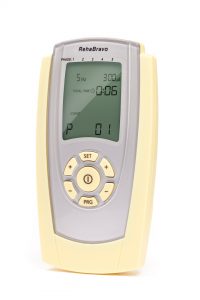Muscle Stimulation (EMS)
It is a known fact that nerves control muscles by transmission of neurological codes. This code or message, depending on the  required type of muscular fibre, will be transmitted in varying frequency bands. The muscle begins to contract when it receives electrical stimulus, whether the impulse is generated by the brain or by electrical stimulation. The physiological method of neuromuscular stimulation require impulses, that are similar in condition to the naturally occurring nerve signals. Provided that the imitation of nature is as exact as possible, electrical stimulation may, if necessary, be applied over a long periods of time, without causing side effects.
required type of muscular fibre, will be transmitted in varying frequency bands. The muscle begins to contract when it receives electrical stimulus, whether the impulse is generated by the brain or by electrical stimulation. The physiological method of neuromuscular stimulation require impulses, that are similar in condition to the naturally occurring nerve signals. Provided that the imitation of nature is as exact as possible, electrical stimulation may, if necessary, be applied over a long periods of time, without causing side effects.
Enhancement of physical capabilities by training or electrical stimulation can be related back to the fact, that the human body is able to adjust to changing environmental conditions.
If the muscular stress increases to a certain threshold, the muscles will adapt to the strain. The increase of muscular power is initially due to improved intra-muscular co-ordination, which means that for each movement more fibres will be activated simultaneously than before. Only in the second step the muscular mass will increase.
Besides the strengthening of the muscles, the furtherance of the muscular blood circulation is an additional main t of the electrical stimulation. A higher capillary density enable the improved blood circulation. Hence an increase supply of nutritive substances, especially oxygen, is made available and the aerobic metabolism especially benefits. Electrical stimulation not only allows an improvement of the supply, but also furthers the fast disposal of metabolic waste products like lactic acid, or carbon dioxide.